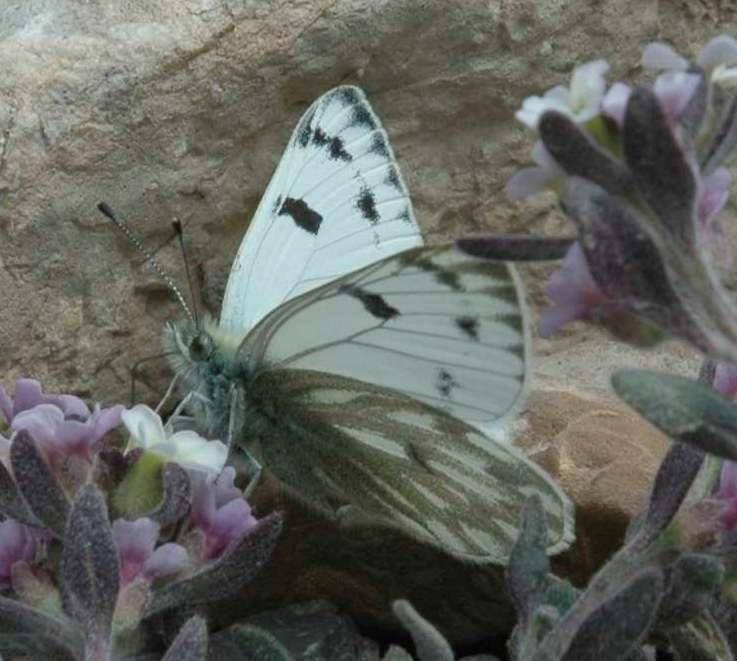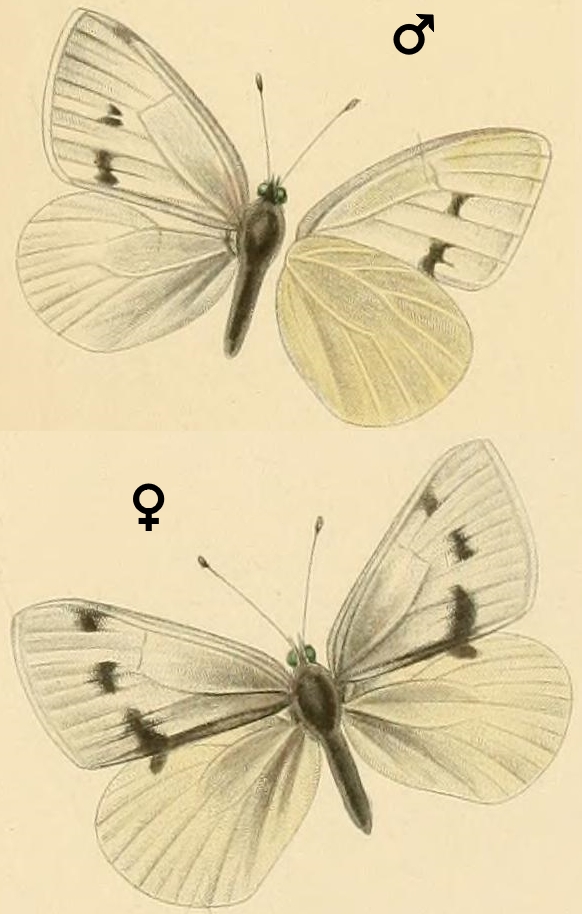|
Pontia
''Pontia'' is a genus of pierid butterflies. They are found in the Holarctic, but are rare in Europe and central to eastern North America, and a few species range into the Afrotropics. Several East Asian species once placed here are now more often split off in '' Sinopieris''. Like the closely related genus '' Pieris'', they are commonly called whites. Species Listed alphabetically: funet.fi * '' Pontia beckerii'' (Edwards, 1871) – Becker's white, Great Basin white, or sagebrush white * '''' (Hübner, 1799-18 ... [...More Info...] [...Related Items...] OR: [Wikipedia] [Google] [Baidu] |
Pontia Daplidice
''Pontia daplidice'', the Bath white, is a small butterfly of the family Pieridae, the yellows and whites, which occurs in the Palearctic region. It is common in central and southern Europe, migrating northwards every summer, often reaching southern Scandinavia and sometimes southern England. Description * The Bath white is a small white butterfly with a wingspan of 45 to 50 mm. The underside of the hindwing has a pattern of greenish blotches, which is characteristic of the Bath whites and easily identifies it from other pierids. * Sexes can be differentiated by markings on the forewing. The male is differentiated from the female by the markings on the upperside of the forewing. The apex of the forewing is black with white spots and lines. There is a black spot at the end of the cell. In the case of the female, there is an additional discal spot in 1b. The female also has an obscure row of terminal and marginal spots on the upper hindwing. :*Description from C. T. Bingham ... [...More Info...] [...Related Items...] OR: [Wikipedia] [Google] [Baidu] |
Pontia Sisymbrii
''Pontia sisymbrii'', the spring white, California white, or Colorado white, is a butterfly in the family Pieridae. It is found in mountainous areas of western Canada and the United States.Spring White Butterflies of Canada It is mostly white with small black markings; females may be yellowish. Similar to other checkered whites such as, '' Pontia beckerii'', '' Pontia protodice'', and ''''.Jim P. Brock and Kenn Kaufman (2003). ''Butterflies ... [...More Info...] [...Related Items...] OR: [Wikipedia] [Google] [Baidu] |
Pontia Edusa
''Pontia edusa'', the eastern Bath white, is a butterfly in the family Pieridae. Description ''Pontia edusa'' is a small to medium-sized migrant butterfly, with a wingspan reaching about 45 mm. The upperside of the wings is white, with black stains on the top of the forewing and hindwing. The hindwing undersides have greenish-grey spots. The butterfly is nearly identical to ''Pontia daplidice''. Investigations of the genitals are the only way to distinguish between these two types. The adults fly from March to October with two to four generations depending on the latitude. The eggs are laid singly and have an incubation period of seven days. The caterpillars are present from May. They are greyish-greenish, with black dots and broad yellow stripes, quite similar to the larva of the cabbage butterfly (''Pieris brassicae''). The larvae feed on Resedaceae species. ''Pontia edusa'' hibernates in the chrysalis stage. Distribution It is found from the south east of Europe (sou ... [...More Info...] [...Related Items...] OR: [Wikipedia] [Google] [Baidu] |
Pontia Beckerii
''Pontia beckerii'', the Becker's white, Great Basin white, or sagebrush white, is a butterfly in the family Pieridae. It is found in western North America from Baja California, Mexico to southern British Columbia, Canada.Becker's White Butterflies of Canada It is mostly white with small black markings; females have more dark markings. The species is similar to other checkered whites such as, '''', '''', and '' |
Pontia Protodice
''Pontia protodice'', the checkered white or southern cabbage butterfly, is a common North American butterfly in the family Pieridae. Its green larva is a type of cabbage worm. Description The upperside of the wings are white and marked with black and gray, more so on the female than on the male. The underside of the hindwings is marked with extensive yellow-brown veins. The wingspan is . In its pre-adult form, the egg is orange, and mature larvae are black dotted and bluish green to gray with a yellow dorsal, lateral and sublateral stripe. The pupa overwinters, and varies in color from blue-gray to cream. Distribution ''Pontia protodice'' is most commonly found in the southern parts on the United States along with some of the northern areas of Mexico. Occasionally the species can be found in the northern parts of the U.S. and southern Canada. It is absent from the Pacific Northwest and the New England area, although populations have become increasingly erratic just east ... [...More Info...] [...Related Items...] OR: [Wikipedia] [Google] [Baidu] |
Pontia Glauconome
''Pontia glauconome'', the desert white or desert Bath white, is a butterfly in the family Pieridae. It is found in Mauritania, Senegal, Gambia, Niger, Chad, Sudan, Ethiopia, Somalia, Kenya, Arabia, Egypt, the Middle East, Pakistan, Afghanistan, the southern part of the former Soviet Union, Uzbekistan, Tajikistan and Turkmenistan. The habitat consists of sub-deserts. The wingspan is 45–50 mm. Adults are on wing from March to October, in three to four generations per year. The larvae feed on '' Epicastrum arabicum'', '''', '' Caylusi ... [...More Info...] [...Related Items...] OR: [Wikipedia] [Google] [Baidu] |
Pontia Occidentalis
''Pontia occidentalis'', the western white, is a butterfly in the family Pieridae. It is found in Western North America. The wingspan is 38 to 53 millimeters. The host plants are from the mustard or cabbage family, Brassicaceae Brassicaceae () or (the older) Cruciferae () is a medium-sized and economically important family of flowering plants commonly known as the mustards, the crucifers, or the cabbage family. Most are herbaceous plants, while some are shrubs. The leav .... The caterpillars eat especially the flowers, buds and fruit. In the north of the range, one generation flies in June and July; in the south two generations fly from May to August. External links Butterflies and Moths of North-America occidentalis Butterflies of North America Fauna of California Fauna of the California chaparral and woodlands Butterflies described in 1866 Taxa named by Tryon Reakirt {{Pieridae-stub ... [...More Info...] [...Related Items...] OR: [Wikipedia] [Google] [Baidu] |
Pontia Helice
''Pontia helice'', the meadow white, is a butterfly in the family Pieridae. It is found in southern Africa. at Markku Savela's ''Lepidoptera and Some Other Life Forms'' Wingspan is 35–40 mm in males and 37–43 mm in females. Flight period is year-round. The larvae feed on '' Heliophila'' species, '''', '' Lepidum capense'', '' [...More Info...] [...Related Items...] OR: [Wikipedia] [Google] [Baidu] |
Pontia Chloridice
''Pontia chloridice'', the lesser Bath white, is a small butterfly of the family Pieridae, that is, the yellows and whites. The species is found in steppe zone of Ukraine, Moldova and Russia; east to Transbaikalia, Mongolia, Korea; south to Balkan Peninsula, Turkey, Transcaucasia, Greater Caucasus, Iran, Northern Pakistan, Central Asia (including Chitral and Ladakh in Kashmir), Kazakhstan. Description Male upperside ground colour white. The forewing has the discocellulars edged broadly with black on each side; a short broad transverse preapical black bar from costa to vein 6 and another similar short bar further outwards from vein 6 to middle of interspace 4, followed by three outwardly-pointed, somewhat oval, black terminal spots just below the apex. Hindwing: uniform, unmarked. Underside: white. Forewing: the markings as on the upperside, but those at apex green and with a few scattered superposed black scales on the upper preapical bar. Hindwing: basal area green, an oval wh ... [...More Info...] [...Related Items...] OR: [Wikipedia] [Google] [Baidu] |
Pontia Distorta
''Pontia distorta'', the small meadow white, is a butterfly in the family Pieridae. It is found in Ethiopia, Somalia, northern Kenya and possibly north-eastern Tanzania Tanzania (; ), officially the United Republic of Tanzania ( sw, Jamhuri ya Muungano wa Tanzania), is a country in East Africa within the African Great Lakes region. It borders Uganda to the north; Kenya to the northeast; Comoro Islands and .... The habitat consists of sub-desert thorn-bush areas. References distorta Butterflies of Africa Butterflies described in 1886 Taxa named by Arthur Gardiner Butler {{Pieridae-stub ... [...More Info...] [...Related Items...] OR: [Wikipedia] [Google] [Baidu] |
Pontia Callidice
''Pontia callidice'', the lofty Bath white or peak white, is a small butterfly of the yellows and whites family (Pieridae), which occurs in the Palearctic realm. Description Description from Charles Thomas Bingham's (1907) ''The Fauna of British India, Including Ceylon and Burma, Butterflies'', Volume II, pp 178–179. ''Pieris callidice'' (=''Pieris kalora'', Moore, P.Z.S. 1865:449) Male * ''Upperside'': white **Forewing: black at extreme bases of interspaces 1a and 1 and of cell; discocellulars marked with a quadrate black spot; a discal curved series of inwardly dentate spots, the spots in interspaces 1 and 2 generally reduced to a mere trace, often absent; an anterior terminal series of similar but more clearly defined spots at the apices of veins 3 to 7. **Hindwing: uniform, the pattern of the underside visible through transparency; base densely irrorated (sprinkled) with black scales. * ''Underside'' **Forewing: white; basal half of costal margin and quadrate spot ... [...More Info...] [...Related Items...] OR: [Wikipedia] [Google] [Baidu] |
Pieris (butterfly)
''Pieris'', the whites or garden whites, is a widespread now almost cosmopolitan genus of butterflies of the family Pieridae. The highest species diversity is in the Palearctic, with a higher diversity in Europe and eastern North America than the similar and closely related ''Pontia''. The females of many ''Pieris'' butterflies are UV reflecting, while the male wings are strongly UV absorbing due to pigments in the scales. Ecology Many species of this genus have caterpillars which feed on cabbage and other members of the Brassicaceae. The chemical basis of this association with a certain plant group has been studied for over 100 years, and is now known to occur via a number of biochemical adaptations to chemicals called glucosinolates in these plants. In contrast to most other insects, ''Pieris'' caterpillars are able to detoxify these chemicals, and have become so specialised that they will not eat any food without glucosinolates. The ''Pieris'' females, in turn, check for the p ... [...More Info...] [...Related Items...] OR: [Wikipedia] [Google] [Baidu] |




